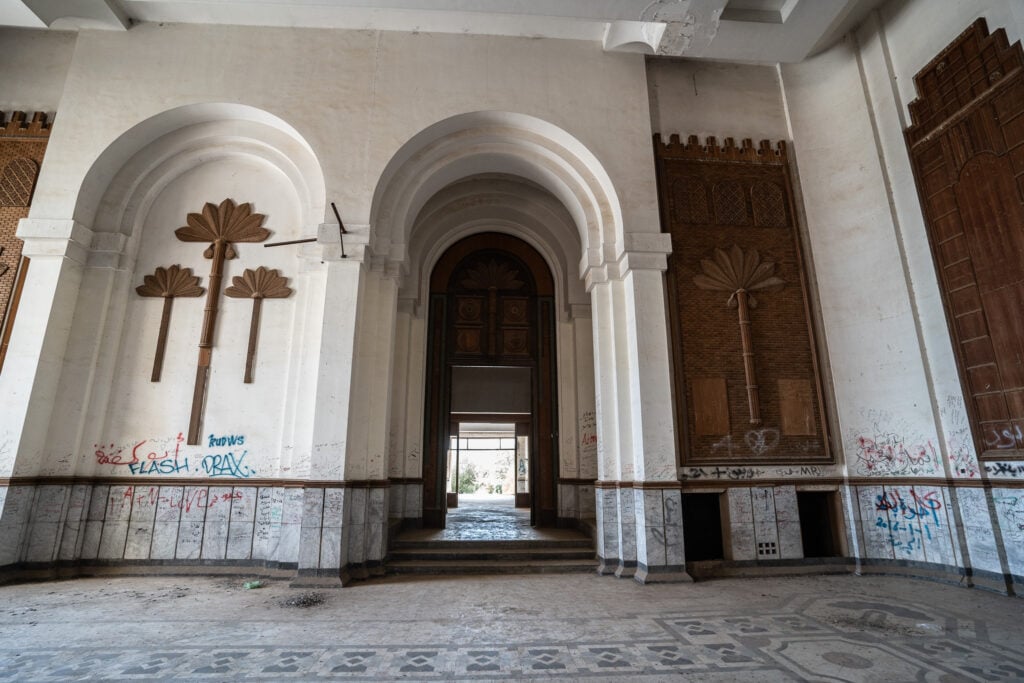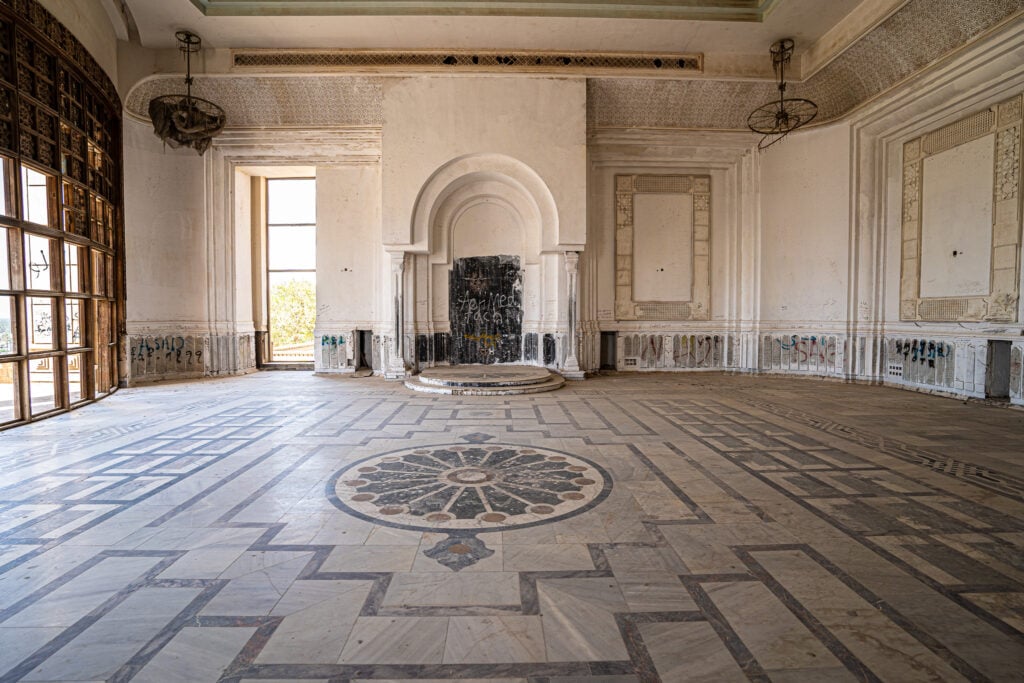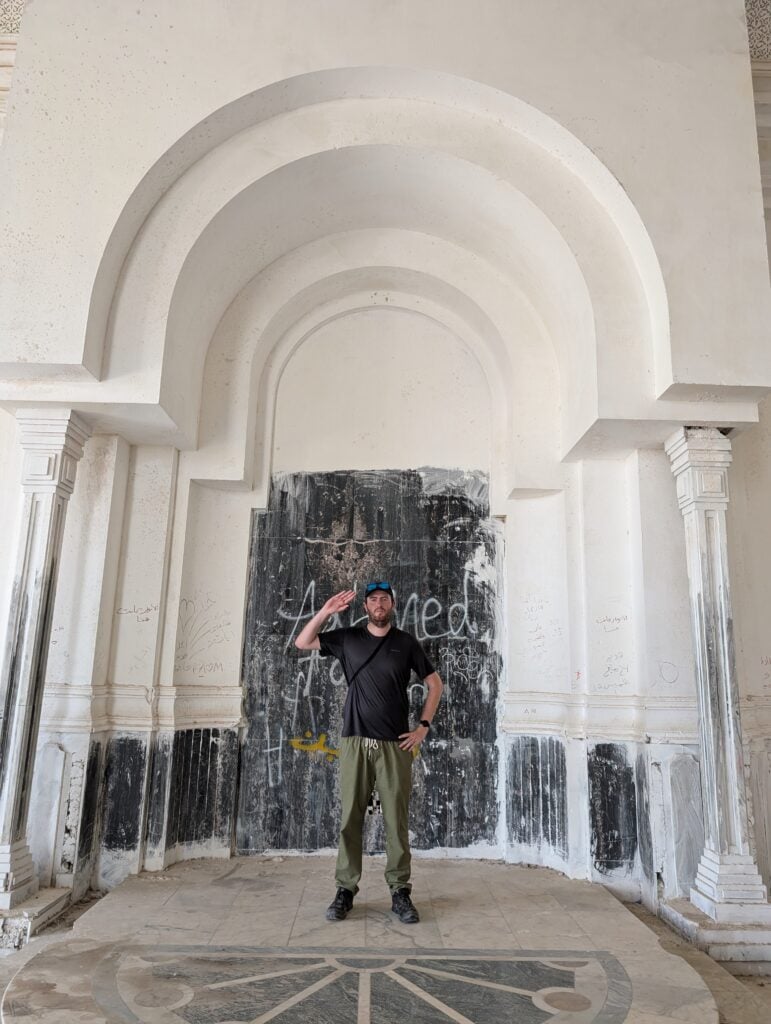On the banks of the Euphrates River in Iraq, a crumbling palace stands as a forlorn memento to the demise of a dictator. Here’s an inside look at Saddam Hussein’s abandoned Babylonian palace.
“My legs were shaking. I was so nervous,” Maki Mohammed recounted with a shy smile as we stood outside the heavy wooden doors leading inside a now abandoned palace on the banks of the Euphrates River in Iraq. “Security informed me that Saddam Hussein wished to speak with me, and you could not say no to that.”
Mohammed worked in one of the many palaces built by the dictator during his 24-year reign in Iraq, and when Saddam called for an audience, you didn’t say no. Mohammed’s legs were twitching even now as he recounted the encounter outside the palace, which today lies crumbling on a hilltop overlooking the ancient city of Babylon in central Iraq.
“He asked me about my time in the army, the wars in Iran and Kuwait,” Mohammed told me as as the midday sun beat down on us. “And at the end, he gave me money. So I could get married.”
Mohammed now works as a caretaker and tour guide in the same palace where he met Saddam Hussein in the 1990s, before the US-led invasion brought the regime crashing down in 2003. In the wake of Operation Iraqi Freedom, Saddam’s Babylonian Palace – and the many more lavish residences he’d built across the country – were looted, and left to decay, a forlorn memento to a fallen dictator bleached white as bones by the fierce desert sun.
Now, Mohammed hopes the ruins can be transformed into a museum, to remember the follies of Saddam Hussein and the endless sectarian violence that followed his downfall. He strolled towards the doors, pushed them open, and beckoned me inside to explore the remnants of the Baathist regime.

Table of Contents
Saddam Hussein’s abandoned Iraqi palaces
The well worn doors creaked open, and I tentatively walked into the lavish entrance hall. The marble underfoot still glimmered through layers of dust, and the unmistakable ‘SH’ motif on the tall walls spoke of the palace’s former occupant. I was dwarfed by the vaulted ceiling, while wooden engravings still adorned the towering archways that led into an even grander throne room beyond.
Saddam Hussein ruled Iraq with an iron fist from 1979 until 2003. The Baathist dictator dragged his nation into a bloody and fruitless eight year long war with Iran, a war which cost the lives of some 250,000 Iraqis and equally as many Iranians between 1980 and 1988. The Iraqi invasion of Kuwait in 1990 precipitated Operation Desert Storm, while Saddam abused his powers, jailing dissidents, executing political prisoners and using chemical weapons against Kurdish rebels in the north. Throughout it all, Saddam’s ego was unsatiable. While his own people suffered, Arab Weekly estimates that the dictator constructed as many as 100 palaces, villas and private residences to the tune of some $2 billion.
On Saddam’s orders, palaces were built in Baghdad, his home city of Tikrit, in Basra, Kurdistan, and elsewhere. This palace to the south of Baghdad was built in true megalomaniacal fashion, towering over the ancient city of Babylon built millennia ago by King Nebuchadnezzar II. If ever there was a statement of power, this is it.





Read more: I Visited Pizza Hut and KFC in Iraq. Here’s What Happened.
Inside the grand throne room
Mohammed knew the story of this particular palace well. In the grand throne, where wide, panoramic windows (the glass shattered long ago) revealed the Euphrates River below, he told me how he’d been born in the village that once stood on this same spot.
In the 1980s, Mohammed was conscripted into the Iraqi army. He fought and was wounded in the bloody Iran-Iraq War, and called up again during the invasion of Kuwait, where he suffered more injuries. While he was serving in the armed forces, Saddam ordered the forced removal of the villagers here to make way for his vanity project.
Through the windows, Mohammed pointed out the village on the dusty horizon where his family moved to, the village where he still lives today. When he returned from war, Mohammed had few opportunities, and he said he was pleased to find a job here in the palace itself. An engineer by trade, he’d helped build the roof that stood above us, a stark irony given that Saddam was the one who’d forced him from his ancestral home.
No wonder he now acted like he owned the palace, strolling around purposefully and showing me the few details from Saddam’s era that hadn’t been looted or destroyed. “The palace was completed in 1994,” he told me. “There were three levels, with elevators, a grand stairwell, jacuzzies. The palace was built only by Iraqi engineers and artists. All the staff were Iraqi. Saddam didn’t trust anyone else.”
Mohammed suddenly stood to attention with a loud crack of his boots on the marble. He pointed at a round motif on the floor, snapped his heels and then saluted. The sound echoed around the throne room. This was the spot, he said, where soldiers were greeted by Saddam, who sat on a gilded chair on the opposite on the opposite side of the cavernous hall. It was here he’d met Saddam in the 1990s, on one of the rare occasions when the dictator had visited the palace that had cost so much to build and furnish.





Read more: 17 Things to Do in Baghdad, Iraq
Looted and left in a ruins
The lifts were out of action. Winding stairwells with a precipitous drop led to the upper levels, where spacious guest rooms were now covered in dust. Mohammed showed me to the rooftop, where the views of Babylon were frighteningly vivid.
The top floor hosted a circular conference room, where Mohammed explained that Saddam and his closest advisors would hatch plots with an equally stupendous view of the Euphrates. Who knows what nefarious schemes were planned out here by Saddam and his Baathist cronies.
Saddam met his demise after the US-led invasion of Iraq in 2003. I well remember growing up watching newsreels showing tanks rolling through the streets of Baghdad. The image of Saddam’s statue being toppled in the capital is one that’s stayed with me, but to be here, in the dictator’s palace, brought the reality of the invasion, and subsequent occupation, home.
He remembers the invasion well. “The Americans attached a large chain to the front door,” Mohammed told me. “Then a Humvee ripped the doors off.” The palace was looted by soldiers, who took anything of value and stole souvenirs as ‘Spoils of War’, even if that age-old practice is outlawed by the Geneva Convention. The international occupation forces not only looted Saddam’s palaces across Iraq, but stole ancient artefacts from historical sights like Babylon. Al Jazeera estimates that in recent years, some 17,000 stolen artefacts have been returned to Iraq. That begs the question: how much has yet to be repatriated?
Mohammed had his own run-in with ‘looters’ amongst the ruins of Babylon. He said he saw an American soldier taken a Cuneiform tablet from the ancient city. When he protested to an officer, he was arrested. When they discovered he’d served in the Iraqi army, they placed him into detention, and he endured a month of questioning and isolation in a Baghdad prison. When he was released, he could barely walk, and spent eight months in a hospital.
“I asked the Americans, ‘Where is the freedom you promised us?'” he said, as we crunched over shards of glass by broken windows. “Why are you doing this? We have been here for thousands of years. You have only been a country for two hundred years.”





Read more: How Many Countries Are in the Middle East? Everything You Need to Know.
A forlorn memento to the demise of a dictator
Throughout the occupation, soldiers scrawled graffiti across the palace walls. Much of it still remains today. Names of US, British, even Polish troops now adorn the conference room, while one artist signed off with the words: ‘Saddam’s Crib, 2003’.
One message read as follows: ‘Dear Saddam, although self guided, we really enjoyed the tour of your palace. P.S. next time spread the wealth.’ Another said simply: ‘Saddam. Remember, people always get what they deserve.’
Mohammed has mixed feelings about the now abandoned palace. For him, it symbolises the dictatorial regime of Saddam Hussein. At the same time, the graffiti and empty hallways have immortalised the grievous years of American-led occupation that followed the dictator’s downfall. Mohammed, and normal Iraqis like him, suffered through both eras, and the palace encompasses all of Iraq’s turbulent history in one crumbling shell.
The National reported in 2022 that Iraq hopes to turn many of Saddam’s looted residences into heritage centres or museums. It’s a move which would cement both Saddam, and the later occupation of Iraq, as historical eras, helping the country to process the past, learn from it and move on. Mohammed welcomes this, and he wants to see the Babylonian palace preserved in this way. For Mohammed, this is also a lasting reminder of his ancestral home, a place linked through millennia to Babylon, and he hopes that more tourists can visit Iraq, understand Iraq, and see how Iraq progresses into its uncertain future.




How to visit Saddam Hussein’s abandoned Babylonian Palace
Saddam Hussein’s Babylonian Palace is located next to the ruins of the ancient city of Babylon, a UNESCO World Heritage site which is a must-see when you’re exploring central Iraq. Babylon is a 1.5 hour drive south of Baghdad (depending on traffic).
From the ruins of Babylon, you can see Saddam’s palace perched on a hilltop above the archaeological site (you can’t miss it!). It’s not far, but given the extreme heat in Iraqi, you may want to have a driver/guide for the day. I travelled to Iraq with local tour operator Bil Weekend who include the palace as part of their Babylon itinerary. They know Mohammed well, and can organise for you to meet him and hear his stories.
There are many more of Saddam’s palaces to visit in Iraq too. There are several in Baghdad, an infamous one in Saddam’s home city of Tikrit, and more in Kurdistan.
Location of Saddam’s abandoned Babylonian Palace:
There you have it, an inside look at Saddam Hussein’s abandoned Babylonian Palace. Are you planning a visit? Let me know in the comments below!



Fascinating read of the day , Exploring the history and remnants of Saddam Hussein’s palace offers such a unique glimpse into the past. Your vivid descriptions really bring the site to life, and I appreciate the context you provided about its cultural significance. It’s a powerful reminder of how history can shape landscapes. Looking forward to more insights on historical sites like this.